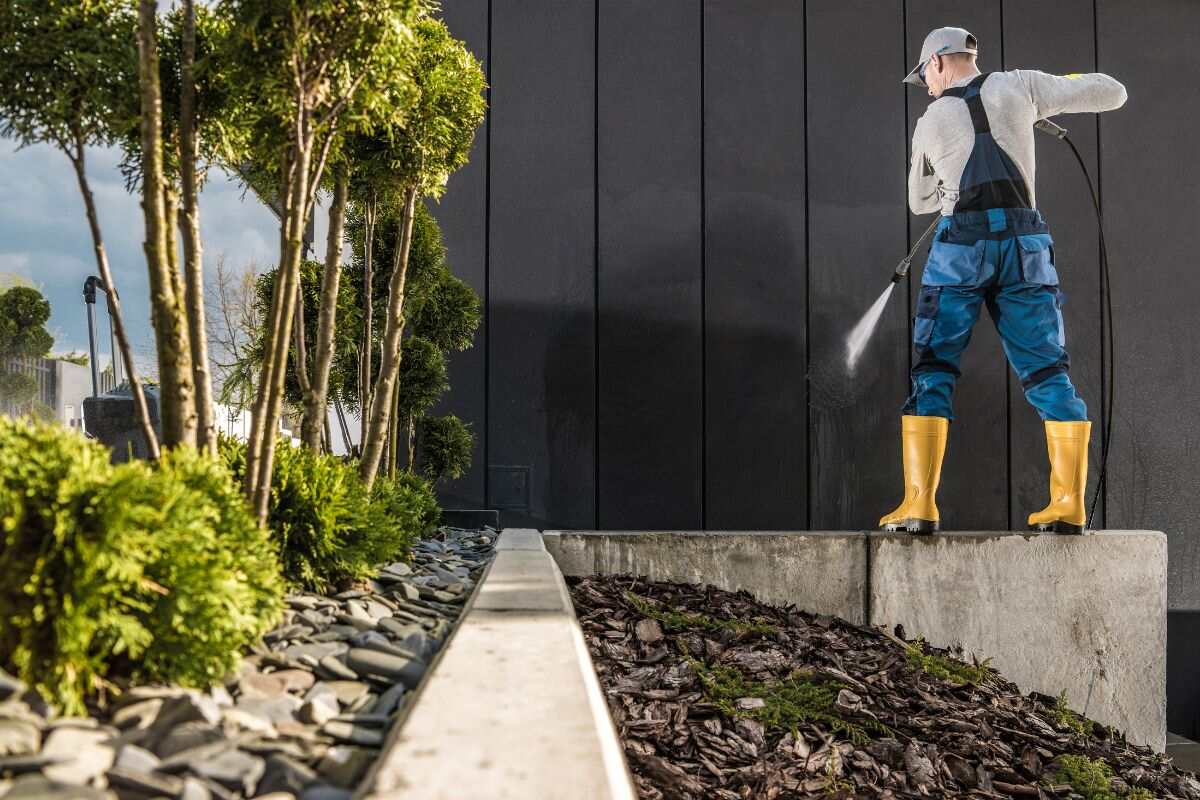
Dirt, mildew, soot, and grime can make your house dingy and dull. Pressure washing is an inexpensive and efficient solution for restoring your home’s luster. But this job requires a little know-how for the best results. Let’s take a look at how to pressure wash a house.
7 Benefits of Power Washing a House
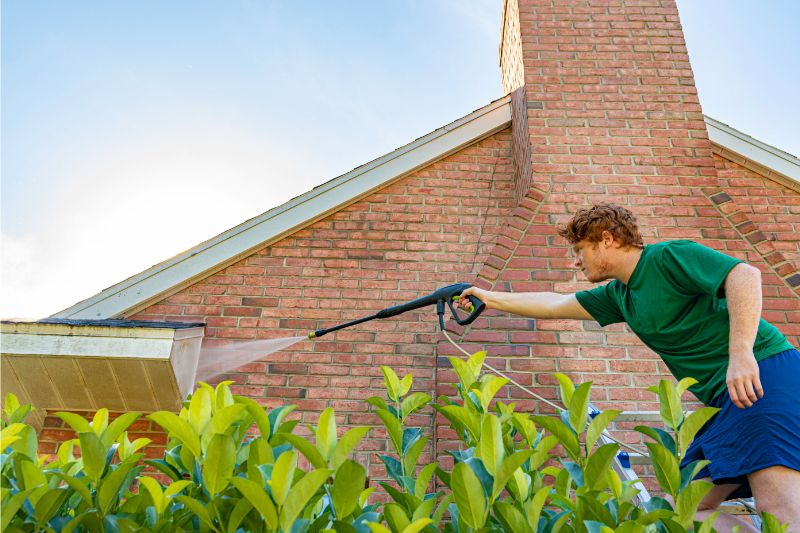
Power washing your home can enhance the appearance and condition of your property by a great deal. Here are a few reasons to do it:
1. Boosts Curb Appeal
Pressure washing gives your home an instant facelift. Removing all that grime reveals a clean surface beneath and makes your home look new again. If you’re planning to sell the house, power washing is a must.
2. Improves Overall Health
Allergens and harmful organisms such as mildew and algae accumulate on the surfaces of your house. If left untreated, they can create airborne mold spores, dust mites, and pollen that can trigger allergies in both children and adults.
Power washing removes all such substances and prevents them from making their way inside the house. Pressure washing regularly will not only improve the appearance of your home but will also help you live a healthier and more comfortable life.
3. Reduces Repair Expense
Layers of dirt and grime can hide details of your home’s exterior. You’re likely unable to see any damaged area of your house covered in dust. This will delay the appropriate repairs your property needs. And while you unintentionally ignore repairing these problems, they will result in more serious issues.
Regular pressure cleaning will remove grime and dirt and reveal imperfect areas that need your attention. Repair costs for small scrapes, dings, or other such damage are more manageable than major repairs or replacements.
4. Primes Surfaces
Power washing the exterior of your house is an excellent way to prime surfaces for paint, stain, or other finishes. New paint will adhere better to a clean, dry surface than a surface coated with dirt, grime, or dust.
If you intend to refinish or repaint the outside of your home, a thorough power washing session can help ensure that the new paint lasts for a long time and looks great.
5. Saves Time and Money
Power washing gives a thorough, powerful, and fast cleaning to every surface of your home’s exterior. Safe to say, it’s the quickest and most convenient way to clean your home. It would take forever to scrub down every surface with a bucket of soap and water and multiple kinds of brushes in your hand.
6. Maintains Property Value
Generally, house values appreciate over time. But that won’t be the case if your house is damaged, rundown, or dirty. Regular power washing ensures that your house will hold its value.
7. Reduces Chances of Injury
Pressure washing driveways, sidewalks, walkways, and parking garages can get rid of mold, greasy buildup, and other substances that make the surface slippery. Cleaning these surfaces reduces the chances of slips and accidental injuries to everyone using them.
Materials and Tools You Will Need
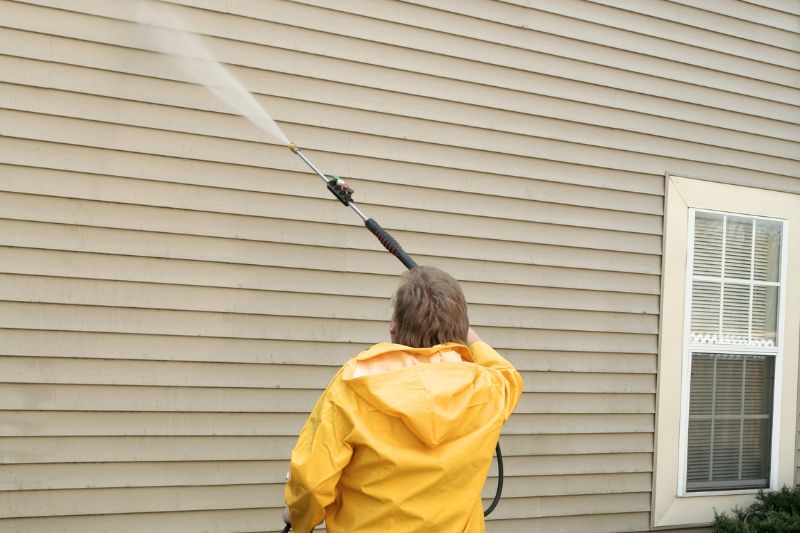
Here’s all that you will need for the job:
- Duct tape
- Detergent
- Stiff brush
- Garden hose
- Drop cloths
- Mixing bucket
- Garden sprayer
- Safety goggles
- Bleach
- Extension wand
- Pressure washer
Choosing the Right Pressure Washer
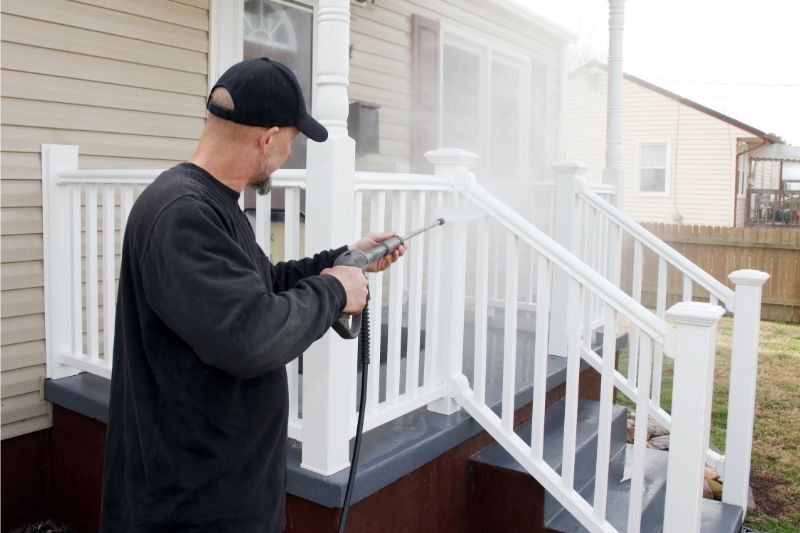
Pressure washers come in several different varieties. There’s a lot to decide: buy one or rent, the power level, which nozzle to use, or if an electric-powered washer is better than a gas one.
Let’s find out.
Gas or Electric Powered?
For cleaning the exterior of a house, a heavy-duty gas-pressure washer is ideal. Gas-powered washers generally have higher flow rates, measured in Gallons Per Minute (GPM) to clean quickly and more effectively.
Electric pressure washers work really well for smaller jobs and have the benefit of being highly portable. Here’s a guide to some of the best electric pressure washers.
What are PSI and GPM?
The power of your pressure washer is measured in PSI (Pounds per Square Inch) and GPM (Gallons Per Minute). Both measurements are oriented towards the output. A machine with a higher GPM is more powerful than a machine with more PSI and lower GPM.
Choose a power washer with at least 2.3 GPM and 2,600 PSI to clean your house. These pressure washers are quite strong and need to be operated 2 feet or so from the surface to avoid damaging siding and other house features. Go for lower PSI, between 1,200 and 1,600, if you have a softer material for sidings, such as aluminum or wood.
Which Nozzle to Use?
You will need two types of pressure washer nozzles to clean a house. First, you will use the soaping nozzle to apply the detergent, then either a 25 or 40-degree nozzle tip to pressure wash.
Buy or Rent?
Pressure washers are quite affordable. So, investing in one is a good idea if you plan to use it regularly – and you should. The average cost of a pressure washer is $246. Here are the best 10. Renting one costs around $38 to $42 per day on average.
Preparing to Pressure Wash a House
The high-output stream from a pressure washer is no joke. It can cause injury or damage surfaces if you don’t know what you’re doing. Here are some simple things you should do before you start:
- Put on your protective gear. Long-sleeve shirts and long pants and closed-toe shoes or work boots are recommended. Safety goggles are a must if you’re using detergent or bleach.
- Turn off or cover all the external electrical outlets with plastic or tape.
- Make sure all the doors and windows are closed.
- Trim all the plants and shrubbery that could get in the way.
- Remove all the obstacles from your work area. This includes bikes, toys, outdoor furniture, etc.
- Cover plants with a tarp or plastic sheet and secure the tarp in place with duct tape or bricks.
- Don’t stand on a ladder to reach high areas. The pressure stream can make you lose balance. Instead, use an extension pole.
- If the sidewalks, walkways, driveway, or any other exterior part of your house has cracks or holes, do not drive water directly into these gaps. The high-pressure stream will chip away at the cracks. Patch cracks and holes with the help of this guide.
- Pre-soak the surface with a detergent and use a soft-bristle brush to remove any caked on dirt.
6 Steps to Pressure Wash A House
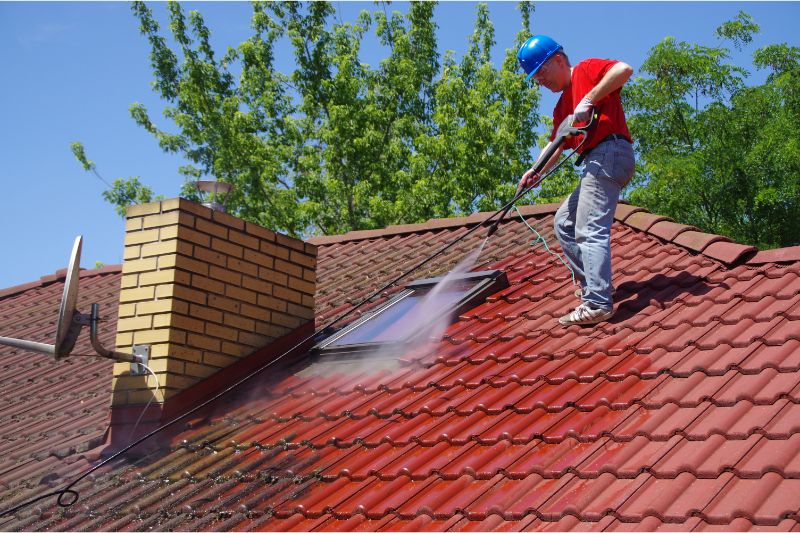
Here are some simple guidelines:
1. Set Up the Pressure Washer
After you’ve prepped the exterior of your house, set your pressure washer up for a thorough job.
Mix water and cleaning detergent in a bucket according to the manufacturer’s instructions. For best results, use a detergent formulated to kill mildew. Add one part bleach for every nine parts detergent in the bucket. Pour the detergent into the garden sprayer.
Attach the garden hose to the pressure washer and attach the spray nozzle labeled for applying detergent. Again, be sure your goggles are in place.
When it’s all set, take a few steps back from your house and test the pressure washer against the surface.
2. Spray the House
Start by spraying the detergent on the siding thoroughly. Sweep the sprayer horizontally along the house, gradually moving from bottom to top. Your strokes should be firm but slow. Use an extension pole for higher areas while keeping a downward angle.
If you see any problem spots, use a soft brush to scrub the surface clean.
3. Let it Rest
Once you’ve applied the detergent, wait 10 to 15 minutes for it to work its magic. This gives the detergent time to begin breaking up grime so it comes off easily.
4. Rinse
Remove the foaming nozzle from the spray wand and attach the 40 or 25-degree nozzle.
Holding the sprayer 2 to 3 feet from the surface, test rinse a small area to see what distance works best. If you notice the dirt coming off from that distance, great. But if you still see spots, move a bit closer and see if the cleaning power is right without causing any damage. If the reduced distance still doesn’t work, move closer in increments of 4 to 6 inches.
Once you know the appropriate distance, work from top to bottom and power wash your house. Rinsing from the top down will provide maximum coverage. Again, spray in a consistent, side-to-side motion. Clean the overhangs and gutters first and maintain a 45-degree angle.
5. Repeat for All Sides
Move to the next section of siding and repeat steps 2, 3, and 4. Once you have pressure washed the entire house, turn off the pressure washer and disconnect the garden hose.
6. Finish Up
When you’re done cleaning, pull up all the plastic sheets, tarps, drop cloths, and tape. Refer to the machine’s manual and store the pressure washer appropriately. Failing to drain the remaining water or detergent from the washer may damage it.
If you plan to paint the exterior, wait two to three days for the house to dry completely.
Safety Tips
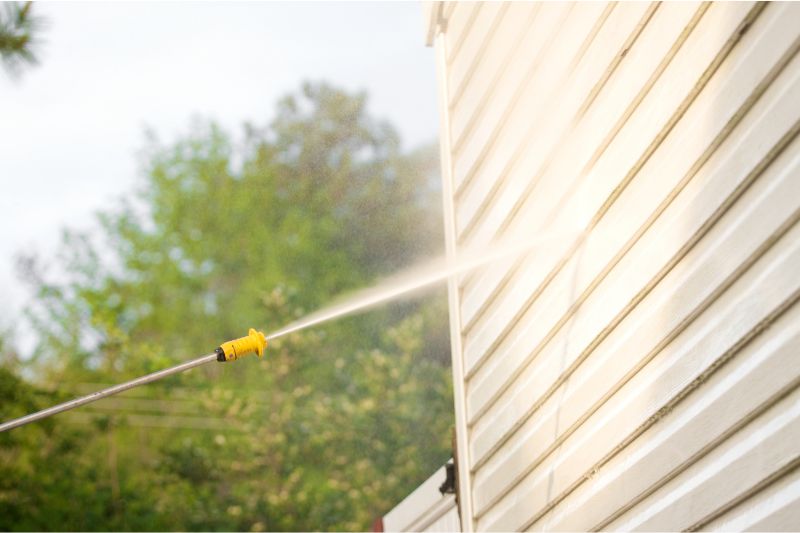
A few do’s and don’ts of power washing your house:
Do
- Always test your pressure washer on a discreet area so that you don’t have to worry about denting, etching, or peeling the surface.
- Keep the pressure washer in motion. Holding it in one spot may damage the surface.
- Select mild cleaning solutions whenever possible. Harsh cleaners may get into surrounding landscaping and damage it.
- Keep your strokes steady and firm.
- Start on a low-pressure setting and increase it gradually. Practice your technique before starting on the actual house exterior.
- Double-check all electrical outlets and properly cover them with duct tape. Also, be sure overhead power lines don’t come in contact with the extension wand.
Don’t
- Don’t use super hot water thinking it will be more effective at removing grime and dirt. Water temperature is irrelevant since this machine cleans with the pressure of water.
- Don’t increase the pressure when you’re using the machine. The sudden jerk might knock you down or cause damage to the surface you’re spraying.
- Never use a pressure washer for windows, even on a low setting, no matter how tough they seem. Pressure can easily damage or weaken the seals on exterior windows.
- Don’t angle the spray too much because that will lessen the water pressure. Hold the spray wand at a slight angle or straight on. You can use a pivot nozzle in areas where you cannot hold the sprayer straight.
- Don’t point the pressure washer at another person, pet, plant, vehicle, or accessory. The pressure is strong enough to damage skin.
- Never use a ladder when power washing.
Frequently Asked Questions
It can take as little as 30 minutes to an hour to pressure wash a one-story 2,500-square-foot house. Depending on the extent of dirt and size of the house, you may need to invest as much as 3 hours or more.
The best time to pressure wash a house is between March and November. You’ll want a streak of clear, sunny days so the house dries up quickly.
You can pressure wash your house every year. But homeowners living near a busy road, with lots of surrounding trees, or where it’s generally dusty, stormy, and windy might need to do it in the spring and fall.
Don’t Feel Like Pressure Washing? Call the Pros
Power washing can be dangerous and downright scary for most of us. If you’re not up for such an extensive DIY project, you can always reach out to our home improvement experts in your area. From preparation to after-cleaning, they will handle everything for you.
Main Image Credit: welcomia / Canva Pro / License
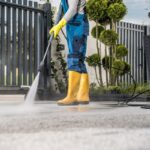
![6 Best Electric Pressure Washers of 2023 [Reviews]](https://www.lawnstarter.com/blog/wp-content/plugins/related-posts/static/thumbs/15.jpg)
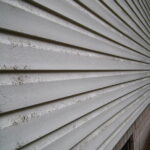
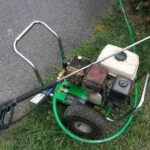
![10 Best Pressure Washers of 2023 [Reviews]](https://www.lawnstarter.com/blog/wp-content/plugins/related-posts/static/thumbs/30.jpg)
![10 Best Gas Pressure Washers of 2023 [Reviews]](https://www.lawnstarter.com/blog/wp-content/plugins/related-posts/static/thumbs/22.jpg)